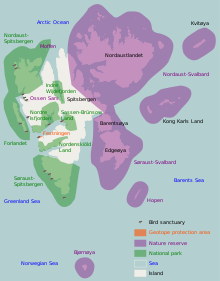

Svalbard is an Arctic wilderness archipelago comprising the northernmost part of Norway. There are twenty-nine protected natural areas, consisting of seven national parks, six nature reserves, fifteen bird sanctuaries and one geotope protected area.[1] In addition, human traces dating from before 1946 are automatically protected.[2] The protected areas make up 39,800 square kilometers (15,400 sq mi) or 65% of the land area, and 78,000 square kilometers (30,000 sq mi) or 86.5% of the territorial waters. The largest protected areas are Nordaust-Svalbard Nature Reserve and Søraust-Svalbard Nature Reserve, which cover most of the areas east of the main island of Spitsbergen, including the islands of Nordaustlandet, Edgeøya, Barentsøya, Kong Karls Land and Kvitøya. Six of the national parks are located on Spitsbergen. Ten of the bird sanctuaries and the Moffen Nature Reserve are located within national parks. Five of the bird sanctuaries are Ramsar sites and fourteen of the bird sanctuaries are islands.[1] Svalbard is on Norway's tentative list for nomination as a UNESCO World Heritage Site.[3]
The supreme responsibility for conservation lies with the Norwegian Ministry of the Environment, which has delegated the management to the Governor of Svalbard and the Norwegian Directorate for Nature Management. The foundation for conservation was established in the Svalbard Treaty of 1920, and has been further specified in the Svalbard Environmental Act of 2001.[4] The first round of protection took force on 1 July 1973, when most of the current protected areas came into effect. This included the two large nature reserves and three of the national parks. Moffen Nature Reserve was established in 1983, followed by four national parks, three nature reserves and one geotope protection area between 2002 and 2005.[1]
Two primarily terrestrial mammalian species inhabit the archipelago: the Arctic fox and the Svalbard reindeer. There are 15 to 20 types of marine mammals, including whales, dolphins, seals, walruses, and polar bears. About 30 types of bird are found on Svalbard, most of which are migratory. The Barents Sea is among the areas in the world with most seabirds, with about 20 million individuals during late summer. Sixteen bird species are on the IUCN Red List. In particular, Bjørnøya, Storfjorden, Nordvest-Spitsbergen and Hopen are important breeding grounds for seabirds. Svalbard has permafrost and tundra, with both low, middle and high Arctic vegetation. There have been found 165 species of plants on the archipelago,[1] although vegetation only covers 10% of the island group.[5] Low precipitation gives the archipelago a steppe climate; however plants still have good access to water because the cold climate reduces evaporation.[1][6] The growing season is very short, and may last only for a few weeks.[7]
- ^ a b c d e "Protected Areas in Svalbard". Norwegian Directorate for Nature Management. Archived from the original on 29 February 2012. Retrieved 14 May 2010.
- ^ Umbriet (2005): 132
- ^ "Svalbard". UNESCO. Retrieved 24 March 2010.
- ^ Backer, Inge Lorang. "Svalbardloven" (in Norwegian). Norwegian National Authority for the Investigation and Prosecution of Economic and Environmental Crime. Archived from the original on 9 October 2007. Retrieved 27 March 2010.
- ^ Torkilsen (1984): 144
- ^ Torkilsen (1984): 101
- ^ Umbreit (2005): 32